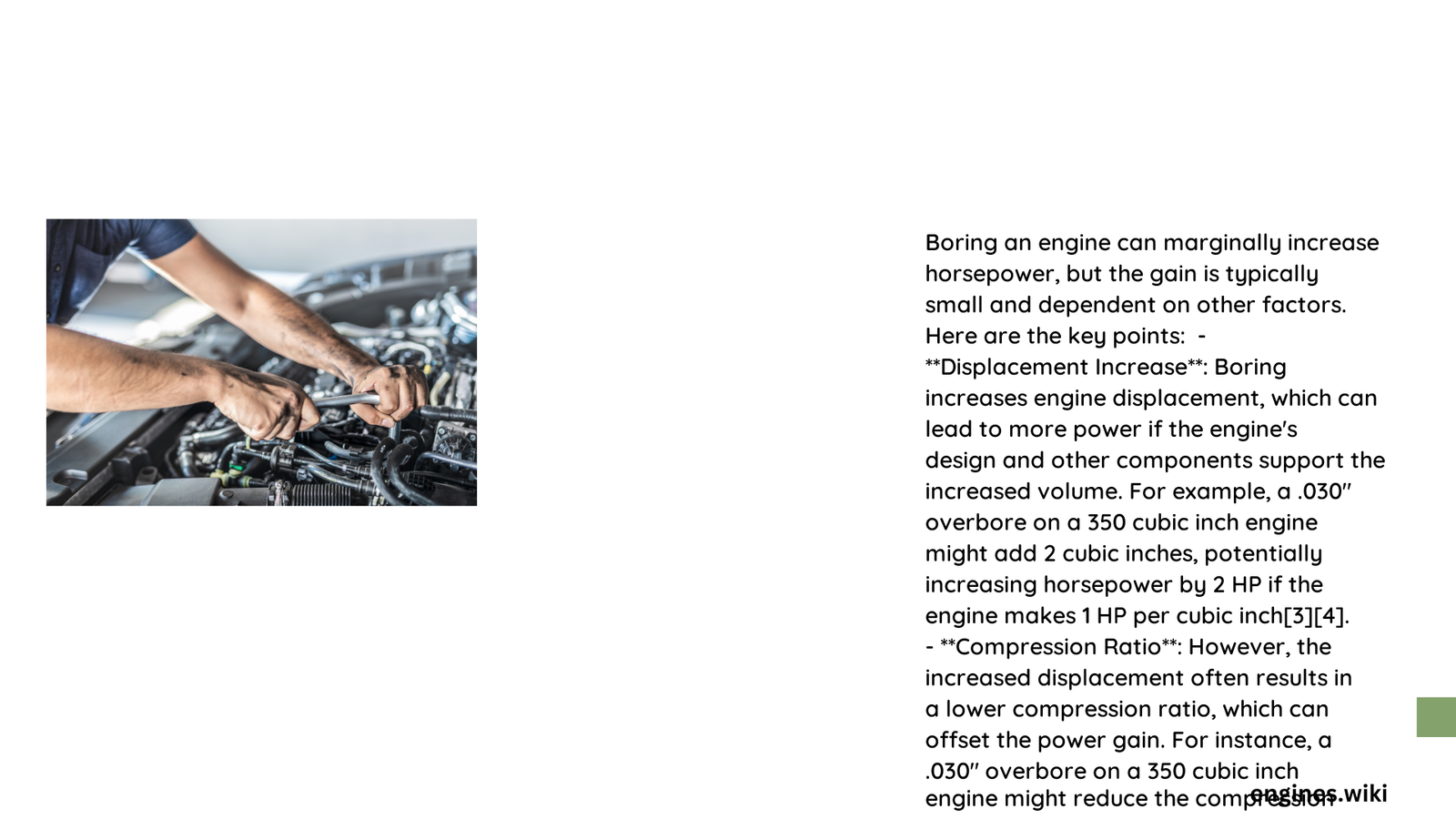Engine boring represents a precision mechanical process where cylinder walls are machined to increase diameter, potentially offering modest horsepower improvements. While enthusiasts often seek significant power gains, the reality involves nuanced performance modifications that require careful engineering considerations and comprehensive understanding of engine dynamics.
What Happens When You Bore an Engine?
Boring an engine involves enlarging cylinder walls to accommodate larger pistons, which incrementally increases engine displacement. This mechanical intervention can yield subtle performance enhancements, but the gains are not as dramatic as many automotive enthusiasts anticipate.
How Much Horsepower Can You Expect?
| Bore Increase | Displacement Change | Potential Horsepower Gain |
|---|---|---|
| 0.030 inches | 1.4% | 1-2% |
| 0.040 inches | 2.0% | 3-4% |
| 0.060 inches | 3.0% | 4-5% |
Mechanical Principles Behind Power Increases
Cylinder Volume Expansion
- Increased displacement allows more air-fuel mixture
- Modest power gains dependent on additional modifications
- Limited by existing engine architecture
Airflow Dynamics
- Potential for larger valve installations
- Improved intake and exhaust flow characteristics
- Performance gains contingent on comprehensive tuning
Critical Performance Considerations
- Cost-Effectiveness Analysis
- Machining expenses
- Replacement component costs
-
Marginal power improvements
-
Technical Requirements
- Precise cylinder wall machining
- Matching piston specifications
- Comprehensive engine reassembly
Factors Limiting Horsepower Gains
- Existing engine design constraints
- Stock component limitations
- Minimal displacement increases
- Requirement for complementary modifications
When Should You Consider Engine Boring?

✓ Significant engine wear
✓ Desire for minor performance enhancement
✓ Part of comprehensive engine rebuild
✓ Professional performance tuning objectives
Potential Risks and Challenges
- Reduced engine reliability
- Increased mechanical stress
- Potential warranty voiding
- Precision machining requirements
Expert Recommendations
Automotive engineers suggest that engine boring alone rarely justifies the investment. Comprehensive performance upgrades involving camshaft, heads, and intake modifications provide more substantial horsepower gains.
Recommended Approach
- Consult professional engine builder
- Evaluate comprehensive modification strategy
- Consider cost-to-performance ratio
- Understand specific vehicle requirements
Conclusion
Engine boring offers modest horsepower increases, typically ranging between 1-5%. While not a transformative modification, it can be part of a broader performance enhancement strategy when executed with precision and complementary upgrades.
Key Takeaways
- Minimal horsepower gains
- Requires professional expertise
- Part of comprehensive engine development
- Cost must be carefully evaluated
Technical Specifications to Consider
- Original engine displacement
- Desired bore increase
- Intended performance objectives
- Budget constraints
Performance Metrics Benchmark
- Stock engine performance
- Anticipated power gains
- Modification complexity
- Long-term reliability implications
Recommended Next Steps
- Professional engine assessment
- Detailed performance analysis
- Comprehensive modification planning
Technical Expertise Required
- Advanced mechanical knowledge
- Precision machining skills
- Understanding of engine dynamics
Investment Considerations
- Machining costs
- Replacement component expenses
- Potential performance gains
- Long-term engine reliability
Final Recommendation
Boring an engine provides marginal horsepower increases. Enthusiasts seeking significant performance improvements should consider holistic engine modification strategies.
